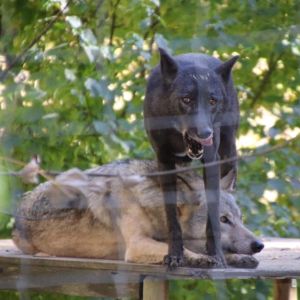The wolf is not bad as fairy tales tell
Alina Maccarino (Intern)
01.12.2020
 One day, during the first weeks of my internship, I heard a child during his visit to the WSC saying to his parents: “Look at this big bad wolf, now he will eat us!”. This statement is a consequence of the fact that wolves, since the past, have often been described with scary nicknames in many fables, legends and myths that frighten children and recommend to stay away from this species. The wolf, in fairy tales, always has a negative role, and is portrayed as a vampire, werewolf or bogeyman. In the past, cattle breeders feared wolves, so they were victims of poaching with the consequence of a reduction in number, delimitation of territory and loss of their ecological role. Unfortunately, nowadays wolves are still discriminated and hunted in various countries. The emblematic key is their ecological role: in fact, this species is, by nature, an extraordinary predator, but it is not “an evil animal”, it attacks only to defend itself when it feels attacked. It seems dangerous only because it must survive and feed.
One day, during the first weeks of my internship, I heard a child during his visit to the WSC saying to his parents: “Look at this big bad wolf, now he will eat us!”. This statement is a consequence of the fact that wolves, since the past, have often been described with scary nicknames in many fables, legends and myths that frighten children and recommend to stay away from this species. The wolf, in fairy tales, always has a negative role, and is portrayed as a vampire, werewolf or bogeyman. In the past, cattle breeders feared wolves, so they were victims of poaching with the consequence of a reduction in number, delimitation of territory and loss of their ecological role. Unfortunately, nowadays wolves are still discriminated and hunted in various countries. The emblematic key is their ecological role: in fact, this species is, by nature, an extraordinary predator, but it is not “an evil animal”, it attacks only to defend itself when it feels attacked. It seems dangerous only because it must survive and feed.
However, looking at past times, we also find different situations, for example tribes of American Indians, such as Pueblo, Shoshoni, Sioux and Cheyenne, considered the wolf as a totem / sacred creature, attributing to it powers related to hunting, healing and war. In addition, hunters from Nunamiut, a population living in the Brooks Range at the Arctic Circle, took the wolf as a model to look for a way to improve and adapt themselves to their hard environment.
Now this species, due to the continuous construction of human settlements, the livestock activity that leads to the fragmentation of the territories, experiences the reduction of preys. Consequently, wolves must approach suburban areas with the risk of influencing their genetic heritage and extinction caused by the transmission of diseases and hybridization. Luckily, due to the success of various management and protection
plans and awareness campaigns, some local species are repopulating over time, and for example in Italy Appennine wolves have been removed from the list of species at high risk of local extinction.
At the WSC there is always the demonstration that wolves are fantastic creatures, just looking at how devoted and faithful they are in relation to the trainers and keepers who take care of them every day by several duties like training, animal care, medical training, walks, research projects. I have been here for less than two months but I had a daily chance to perceive how these wolves have their own character and how brave they are when they have to face tasks of new studies. I can mention, for example, how Taima, Tekoa and Maikan, at first, were very scared of approaching the fence to perform a study task; but luckily, thanks to the fantastic help of the trainers, through calling games and moving to other enclosures if necessary, as in the case of Maikan, these subjects have improved to get closer to the fence! Kaspar, one of the older subjects, also sincerely astonish me a lot, because despite its old age it is always ready to perform what is required and because it carried out the tasks required in a study that began in November.
Maybe one of them helped the writer Lief Fearn to rewrite the fable "Little Red Riding Hood" seen from the side of the wolf. I liked a lot "The Tale of the Slandered Wolf That Nobody Listened To" (you can read it at the link: https://exploringyourmind.com/tale-slandered-wolf-nobody-listened/ because it is an alternative fairy tale, which challenges clichés and teaches that all the stories are lived and perceived from people in a different and unique way. In the classic fable the wolf was condemned without anyone asking its point of view, it was judged a bad subject only because it was misunderstood and misinterpreted! To sum up, the morality of the rewritten fairy tale is to always listen to the others.
Enjoy your reading!